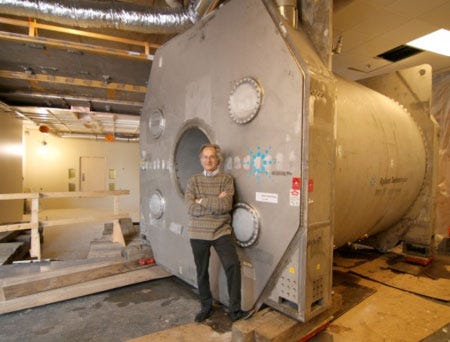MRI Machine Taps Huge Magnet to Offer Ultrahigh Resolution
December 13, 2013
A new 10.5-T MRI can take images of the whole body but it will be first used to study the brain. "We hope to understand how the human brain works, or get close to understanding how the brain works, and then we hope to use that information to understand what happens during brain diseases and other perturbations in the brain," says Kamil Ugurbil, PhD, director of the University of Minnesota's Center for Magnetic Resonance Research (CMRR), in a Minneapolis StarTribune video covering the delivery of the giant MRI magnet to its new home at the CMRR.
The unit's magnet, built in the United Kingdom, is the most powerful ever constructed for an MRI machine. One tesla equals 10,000 gauss. The higher the field strength of an MRI magnet, the finer the resolution achievable. Most hospital MRI magnets generate between 1.5 and 3 T. A 7-T machine, currently the most powerful approved by FDA for human use, is able to resolve to about 1 cubic millimeter. The researchers hope that the new magnet will capture structures down to about 0.2 cu mm.
|
CMRR director Kamil Ugurbil, PhD with the new 10.5-T magnet inside the CMRR building, ready for the final move into its shielding. (Courtesy University of Minnesota) |
"The kind of information that we need to generate an accurate wiring diagram of the human brain simply doesn't exist," says Ugurbil. "This will enable us to be unique in terms of human brain studies." He is one of two principal investigators in the brain-mapping Human Connectome Project, and is also part of NIH's $100-million Brain Research through Advancing Innovative Neurotechnologies (BRAIN) Initiative.
The 105-TMRI was funded by and $8 million grant from NIH and is expected to be powered up during the summer of 2014. The new MRI, Ugurbil says, will put the CMRR in a good position to receive grants related to the NIH initiative because it will produce significantly better information about the brain's structure and functioning.
About the Author(s)
You May Also Like



